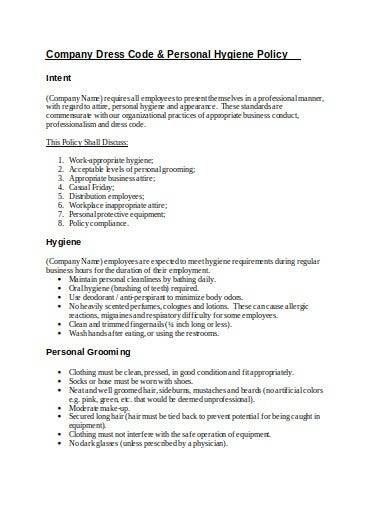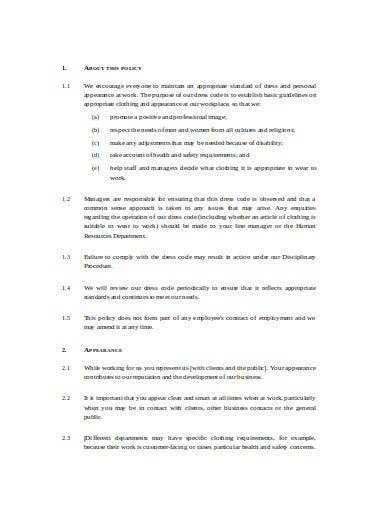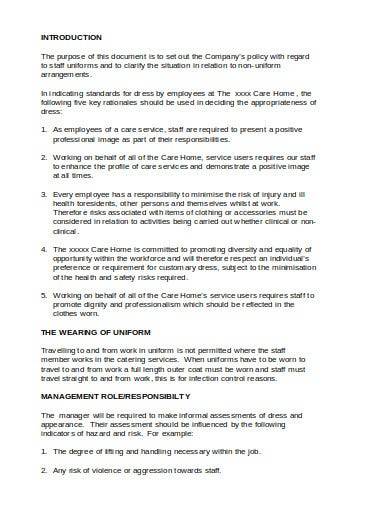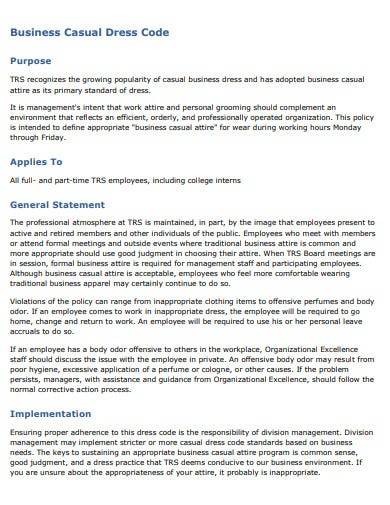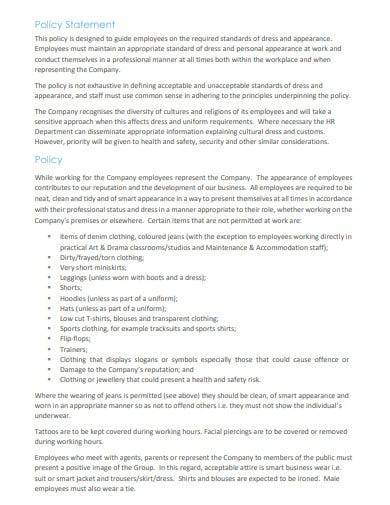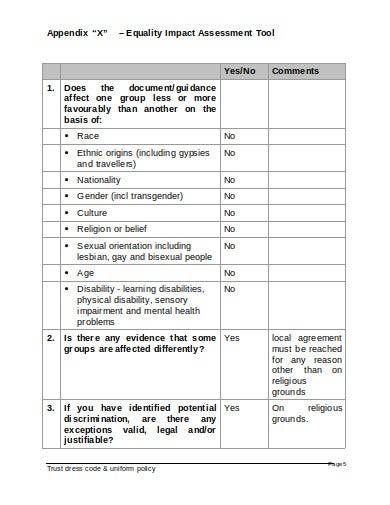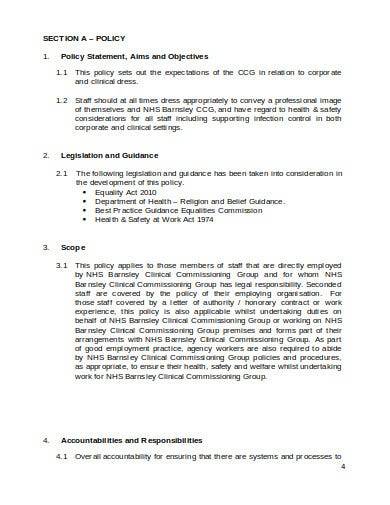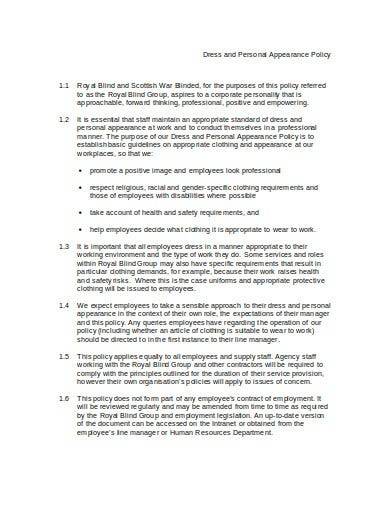What’s in a dress? A lot of things. It contributes to how other people perceive you, it represents your personality, and often, it shows what you do. It is why companies and organizations set standards on how their employees and members should dress when performing their tasks. That’s how they implement a dress code policy. Read more about this as your read below.
FREE 12+ Dress Code Policy Samples
1. School Dress Code Policy Template
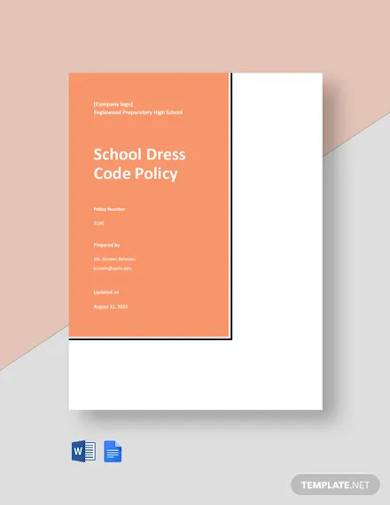
2. Restaurant Dress Code Policy Template
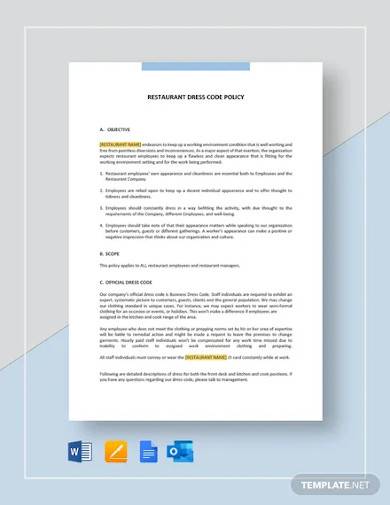
3. Company Dress Code & Personal Hygiene Policy
4. Sample Associates Dress Code Policy
5. Sample Dress Code Policy Template
6. Business Casual Dress Code Policy
7. Sample Appearance & Attire Policy Template
8. Dress Code and Appearance Policy Statement
9. Standard Dress Code Policy
10. Trust Dress Code Policy Template
11. Simple Dress Code and Appearance Policy
12. Printable Dress Code Policy Template
13. Dress and Personal Appearance Policy
What Is a Dress Code Policy?
A dress code policy is an outline of rules addressing the appropriate attire for members or individuals inside a premise. It is common in companies and academic institutions. Dress codes are often based on an organization’s culture and customs. For those who have to constantly deal with clients and want to project a reputable image, they’re usually required to dress professionally. On the other hand, those who work in production need to dress comfortably with all the necessary protective gears.
Why Implement Dress Codes
Would you be willing to pay a fine so that you can wear your favourite jeans and shirt at work? Apparently, one in three workers would pay $5,000 for that, according to a survey by Randstad US. How the organization implements its dress code matters to their employees. An Infographic by the Point Park University shows that 67% of the employees dedicate a specific wardrobe for all their office attires. While almost everyone would prefer casual attire rather than a suit and tie, there are reasons why an industry would demand them to be in their best and formal clothes.
Here are some reasons why dress code implementation matters:
1. It’s a way to unite an organization. When everyone follows a synonymous attire, it makes employees think that they’re part of the group. No one would feel like they’re overdressing because there’s a standard that they need to follow. It’s also easier to find out what clothes to choose everyday.
2. It recognizes the company’s identity. It is how employees will reflect the company’s branding or identity to the public, especially when an organization accepts or meets customers daily. It is also applicable when the organization provides them with uniforms to reflect the image the company is trying to portray.
3. It emphasizes appropriateness and safety. Those who are working in industries that are constantly at risk of things such as falling debris, slippery grounds, chemical intoxication, and heavy-duty machines need to have a certain dress code that will keep them safe from their immediate environment. It is also part of their company’s safety policy.
4. It provides distinction. Workplaces and establishments such as hotels, resorts, and other places where people often come to visit require their employees to dress in a uniform to help guests distinguish them whenever they need anything. It is also beneficial to their security plan, so no one disguises themselves as an employee dressed casually.
How To Write a Dress Code Policy
Here are some tips on how to create a dress code policy:
1. Express the Policy’s Purpose
Before laying out your rules, let them know why there’s a need for a specific dress code in the organization. Explain what the policy will achieve and why it’s important for your company. It might be because you’re in the industry that needs to make a strong impression wherever you go. You might also want to portray yourselves as someone the clients can rely on as your brand’s representatives. Your policies often have to work towards accomplishing your organization’s goal plans.
2. Lay Out the Guidelines
The guidelines contain the outline of rules in implementing your policies. It includes matters concerning what clothes to wear and what garments are prohibited in the company. It’s not enough to only express the kind of dress code that you allow within your premise. For example, if you’re going to say business casual, that’s open to your member’s interpretation of what they consider as business casual. Specify if you allow sleeveless blouses and if there’s a standard for skirt lengths. You can also point out what kinds of footwear are allowed. Aside from clothes, you can also include rules for tattoos and other accessories. This way, it makes your document clear and actionable.
3. Specify the Penalties
Include what penalties await them should they choose to breach the dress code deliberately. State if they’ll receive a warning letter for the first offence and if they need to pay a fine after stubbornly continuing the violation. You can also demand a notice to explain (NTE) from them. Emphasize if a grave offence against the code will soon mean termination. Don’t forget to explain the process to this, so they’ll know how to handle when they get in the situation.
4. Include Exceptions
Casual Fridays are popular for a reason. In offices where dress codes are a thing, it’s the only time in a week where they can dress however they want. Allow some exceptions when implementing your company policy. You can also make exceptions for those who have different beliefs and would like to dress a certain way according to their customs. Include instructions on how they can raise their concerns for the policy so that you can accommodate their requests.
FAQs
What are the different types of dress codes?
The different types of dress codes include business professional, business formal, business casual, and casual.
What are some examples of inappropriate office attire?
Some examples of inappropriate office attire are:
- Revealing tops (e.g., backless, tank, midriff, tube, and strapless tops)
- T-shirts Fitting pants (e.g., leggings and Spandex)
- Shorts
- Athletic shoes, flip flops, and beach sandals
Are dress codes legal?
Yes, as long as they don’t discriminate or ask the organization’s member to be provocative.
While it’s undoubtedly comfortable to have the freedom to throw in whatever you want to wear for work, dress codes are important to your organization for a numer of reasons. Mostly, it’s a way for them to establish their image. It’s also a way to secure safety and convenience. Our dress code policy templates can help your set your rules on this matter. Check them out!
Related Posts
FREE 10+ Size Chart Templates in MS Word PDF | Excel
FREE 8+ Stock Clerk Job Description Samples in MS Word PDF
FREE 12+ Dry Cleaning Receipt Samples & Templates in PDF Excel
FREE 8+ Persuasive Essay Samples in MS Word PDF
FREE 9+ Sample Employee Uniform Forms in MS Word PDF
FREE What to Include in Your Wedding Program [ With Samples ]
FREE 22+ Requisition Forms in MS Word
FREE 10+ Notice of Legal Representation Samples in PDF MS Word
FREE 53+ Information Sheet Examples in MS Word Pages
FREE 10+ Sample Event Proposal Letter Templates in PDF MS ...
FREE 33+ Sample Amazing Movie Ticket Templates in AI InDesign ...
FREE 7+ Sample Business Invitation Letter Templates in MS Word ...
FREE 17+ Party Agenda Samples and Templates in PDF
FREE 35+ Sample Invitation Letter Templates in PDF MS Word ...
FREE 22+ Sample Music Contract Templates in PDF MS Word ...

